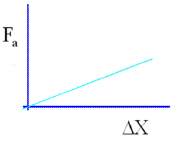Hooke's Law
Hooke's Law explains how "ideal" springs behave under tension.
When no force is applied to a spring, the spring is at rest. It's rest position is X1.
When a force (Fa) is applied to the spring, it will stretch by a certain amount. Its new position will be X2
The amount of stretch is given by the change from position X1 to position X2. This change in position is ∆X.
Where, ∆X.= X2 - X1
The amount of stretch (∆X) .is proportional to the applied force Fa. Therefore:

Graphically, this relationship can be shown as:

The Spring constant depends on factors such:
-
The type of material (spring, elastic band, string...)
-
the diameter of the material (spring, elastic band, string...)
-
the thickness of the material (spring, elastic band, string...)
-
the cross section of the material (spring, elastic band, string...)
-
number of coils in spring (spring, elastic band, string...)





